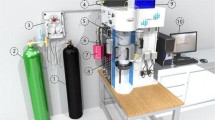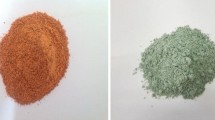Abstract
The determination of specific surface of activated mesocarbons prepared from coal tar pitch by sorption of organic vapors and the operating factors affecting their performances were investigated. Proposed paper deals with alternative experimental method based on weight registration during adsorption of pure vapors of volatile organic compounds VOCs on tested samples. Thermogravimeter TGA-HP50 was used for sorption experiments where activated mesocarbon microbeads were the sorbent and vapors of benzene, toluene, acetone and cyclohexane were used as adsorbate. Primary data were actual weight of the tested sorbent and absolute pressure of organic vapor. Experimental data were fitted by Langmuir model of adsorption isotherm. Specific surface was determined from evaluated parameters. Obtained results were compared with results from standard nitrogen S-BET method. Specific surfaces evaluated from both methods are comparable. The influence of important parameters such as chemical activation, extraction and addition of catalytic agents on activated mesocarbons was studied too. Coal tar pitch as raw material was thermally treated together with Lewis acid (FeCl3). Final solid sorbents were prepared by chemical activation of pyridine-insoluble (PI) matters using potassium hydroxide. Weight ratio of activated agent (potassium hydroxide) to PI matters was 1:5, and temperature of activation was 850 °C. It was found that three samples which were activated had greater specific surface area than the one (B) that was not activated, also as they are appropriate for adsorbing the selected adsorptives.





Similar content being viewed by others
References
Zeinali F, Ghoreyshi AA, Najafpour GD. Adsorption of dichloromethane from aqueous phase using granular activated carbon: isotherm and breakthrough curve measurements. Middle-East J Sci Res. 2010;5(4):191–8.
Rouquerol F, Rouquerol J, Sing K. Adsorption by powders and porous solids: principles, methodology, and applications. San Diego: Academic Press; 1999.
Bansal RCh, Meenakshi G. Activated carbon adsorption. Boca Raton: Taylor; 2005.
Rodriguez-Reinoso, Ed.: Marsh H, Heintz EA. Introduction to carbon technologies. Alicante: Universidad de Alicante, 1997. ISBN 84-790-8317-4.
Tascón J. Novel carbon adsorbents. 1st ed. Boston: Elsevier; 2012.
McCabe WL, Smith JC, Harriott P. Unit operations of chemical engineering. 7th ed. New York: McGraw-Hill; 2005.
Wankat PC. Separation process engineering: includes mass transfer analysis. 3rd ed. New York: Prentice Hall; 2011.
Seader, et al. Separation process principles: chemical and biochemical operations. 3rd ed. Hoboken: Wiley; 2011.
Fuhu L, Weidong Ch, Zengmin S, Yixian W, Yunfang L, Hui L. Activation of mesocarbon microbeads with different textures and their application for supercapacitor. Fuel Process Technol. 2010;91:17–24.
Shen Z, Xue R. Preparation of activated mesocarbon microbeads with high mesopore content. Fuel Process Technol. 2003;84:95–103.
Gensterblum Y, van Hemert P, Billemont P, Busch A, Charrie´re D, Li D, Krooss BM, de Weireld G, Prinz D, Wolf K-HAA. European inter-laboratory comparison of high pressure CO2 sorption isotherms. I: activated carbon. Carbon. 2009;47:2958–69.
Charrière D, Pokryszka Z, Behra P. Effect of pressure and temperature on diffusion of CO2 and CH4 into coal from the Lorraine basin (France). Int J Coal Geol. 2010;81(4):373–80.
Gray MJ, Mebane RC, Womack HN, Rybolt TR. Molecular mechanics and molecular cross-sectional areas: a comparison with molecules adsorbed on solid surfaces. J Colloid Interface Sci. 1995;170(1):98–101.
Livingston HK. The cross-sectional areas of molecules adsorbed on solid surfaces. J Colloid Interface Sci. 1949;4(5):47–458.
Brunauer PH, Emmett E, Teller E. Adsorption of gases in multimolecular layers. J Am Chem Soc. 1938;60:309–19.
DeBoer JB, Lippens BC, Linsen BG, Broekhoff JCP, Heuvel AVD, Osinga ThJ. The t-curve of multimolecular N2-adsorption. J Colloid Interface Sci. 1996;21:405–14.
Barret EP, Joyner LG, Halenda PB. The determination of pore volume and area distributions in porous substances. I. Computations from nitrogen isotherms. J Am Chem Soc. 1951;73:373–80.
Roberts BF. A procedure for estimating pore volume and area distributions from sorption isotherms. J Colloid Interface Sci. 1967;23:266–73.
Lecloux A, Pirard JP. The importance of standard isotherms in the analysis of adsorption isotherms for determining the porous texture of solids. J Colloid Interface Sci. 1979;70:265–81.
Schneider P. Adsorption isotherms of microporous-mesoporous solids revisited. Appl Catal A. 1995;129:157–65.
Sing KSV. Reporting physisorption data for gas/solid system with special reference to the determination of surface area and porosity. Pure and Appl Chem. 1985;57:603–19.
Acknowledgements
Generous support of this study by projects ICT (ED2.1.00/03.0082), ICT-National Feasibility Study (No. LO1406), and National Feasibility Program I, (No. LO1208) is gratefully acknowledged.
Author information
Authors and Affiliations
Corresponding author
Rights and permissions
About this article
Cite this article
Vecer, M., Spitova, B. & Koutnik, I. Determination of specific surface of activated mesocarbons by sorption of organic vapors. J Therm Anal Calorim 121, 429–436 (2015). https://doi.org/10.1007/s10973-015-4597-x
Received:
Accepted:
Published:
Issue Date:
DOI: https://doi.org/10.1007/s10973-015-4597-x




